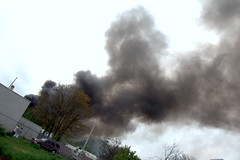
A factory fire in Grand Rapids, Michigan – not the fire mentioned in this post. Photo credit: Steven Depolo on Flickr
Here’s a story from someone who worked on a film set 10 years ago. She said she inhaled smoke on set and from a nearby paint warehouse – though she didn’t realize it at the time.
“There was a lot of atmospheric smoke on set – and I had to go out for fresh air a LOT,” she said. “Then I noticed the air quality outside progressively getting worse than inside. The police showed up and talked to the assistant locations manager, and the locations department told us the police said it was a nearby house fire.
“We kept working through the night, and on the way home in my car, News 1130 reported the fire as being a paint warehouse that was burning, and that local residents had been evacuated. A couple of years later I was suffering from rhinitis – good luck making a claim with a production company that doesn’t exist any more.”
Protecting film industry workers from atmospheric smoke
In Focus on Safety: Safe Work Practices for Film and Television Production in BC there is a section on Smoke and Fog (on Page 85).
“Some artificial-smoke liquids (notably glycols) absorb water and may cause drying of the throat, nose, and sinuses. Artificial-smoke liquids may cause irritation to children, the elderly, and people with allergies or asthma or other respiratory disorders,” it reads.
As for the exposure to the nearby factory fire, that just points to bad organization and an attitude that “the show must go on” once an expensive shoot is underway and expensive crews and equipment are assembled. Fortunately organizations like ActSafe are challenging these attitudes and supporting workers’ safety in the film industry.



Hi Susan.
What an outstanding article. There are so many angles to the problem. Many employers lack education of the impact not only of surrounding atmospheric conditions not directly associated with their activities. Employees (all being different of course) respond different to all sorts of conditions and this is something that employers vary seldom consider. Some employees even have conditions that don’t allow themselves to be exposed (without difficulties) to even the slightest unsettled conditions.
I will add this article to my bank of tools for my consulting practice as I deal a lot with confined spaces as well as workers being exposed to harmful atmospheric conditions. I thing industry is well below where it should be when it comes to these issues. This is based on what I see in the industry.
Hope this isn’t too much info for a comment.
Best regards,
Mike Benz
Hi Susan,
Thanks for your kind comments on Actsafe and for posting the link to the WCB publication, In Focus on Safety: Safe Work Practices for Film and Television Production in BC.
As the industry association funded by WorkSafeBC, we have actually replaced that publication with a series of pocket-sized primers. Some of them are available for download on our website (http://www.actsafe.ca/resources/library/general/), and we send out hard copies to anyone in the industry (working, or trying to work in) film, TV and performing arts.
Primers that I have not uploaded there (but will this fall) include:
Paint safety primer, Dancers and MSI, Musicians and MSI and Motion Picture Safety Primer (Production).
Thanks again for shining a light on some important health and safety stories/issues.
Bev Pausche
Communications Manager
Actsafe BC
Thanks for adding the link